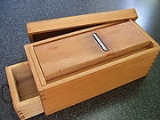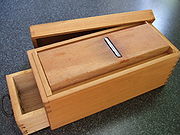
Kezuriki
Encyclopedia

Japan
Japan is an island nation in East Asia. Located in the Pacific Ocean, it lies to the east of the Sea of Japan, China, North Korea, South Korea and Russia, stretching from the Sea of Okhotsk in the north to the East China Sea and Taiwan in the south...
ese kitchen utensil, similar to a wood plane
Plane (tool)
A hand plane is a tool for shaping wood. When powered by electricity, the tool may be called a planer. Planes are used to flatten, reduce the thickness of, and impart a smooth surface to a rough piece of lumber or timber. Planing is used to produce horizontal, vertical, or inclined flat surfaces on...
or mandoline
Mandoline
A mandoline is a cooking utensil used for slicing and for cutting juliennes; with suitable attachments, it can make crinkle-cuts. It consists of two parallel working surfaces, one of which can be adjusted in height. A food item is slid along the adjustable surface until it reaches a blade mounted...
. It is used to shave katsuobushi
Katsuobushi
is the Japanese name for dried, fermented, and smoked skipjack tuna .Shaved Katsuobushi and dried kelp - kombu - are the main ingredients of dashi, a broth that forms the basis of many soups and sauces in Japanese cuisine.Katsuobushi's distinct umami flavor comes from its high...
, dried blocks of skipjack tuna
Skipjack tuna
The skipjack tuna, Katsuwonus pelamis, is a medium-sized perciform fish in the tuna family, Scombridae. It is otherwise known as the aku, arctic bonito, mushmouth, oceanic bonito, striped tuna, or victor fish...
(katsuo).
The technique used to prepare the cooking ingredient is pulling and pushing a block of katsuobushi across the blade in the device in a back-and-forth movement. The resulting shavings are captured in a wooden drawer at the bottom of the instrument and retrieved by opening and emptying the shavings that are roughly sorted into two sizes for different uses.
The shavings are a staple of Japanese cuisine
Japanese cuisine
Japanese cuisine has developed over the centuries as a result of many political and social changes throughout Japan. The cuisine eventually changed with the advent of the Medieval age which ushered in a shedding of elitism with the age of shogun rule...
. Larger, thicker shavings, called , are boiled with kombu
Kombu
Kombu or konbu , also called dashima or haidai , is edible kelp from the family Laminariaceae widely eaten in East Asia....
to make dashi stock
Dashi
Dashi is a class of soup and cooking stock, considered fundamental to Japanese cooking. In 1980, Shizuo Tsuji wrote: "Many substitutes for dashi are possible, but without dashi, dishes are merely à la japonaise and lack the authentic flavor." Dashi forms the base for miso soup, clear broth, noodle...
. Smaller, thinner shavings, called , are used as a flavoring and as a topping for many Japanese dishes, such as okonomiyaki
Okonomiyaki
is a Japanese dish containing a variety of ingredients. The name is derived from the word okonomi, meaning "what you like" or "what you want", and yaki meaning "grilled" or "cooked" . Okonomiyaki is mainly associated with Kansai or Hiroshima areas of Japan, but is widely available throughout the...
.
Today, many Japanese households no longer use the katsuobushi kezuriki, opting instead to buy packages of already-shaved hanakatsuo or kezurikikatsuo at supermarkets.

